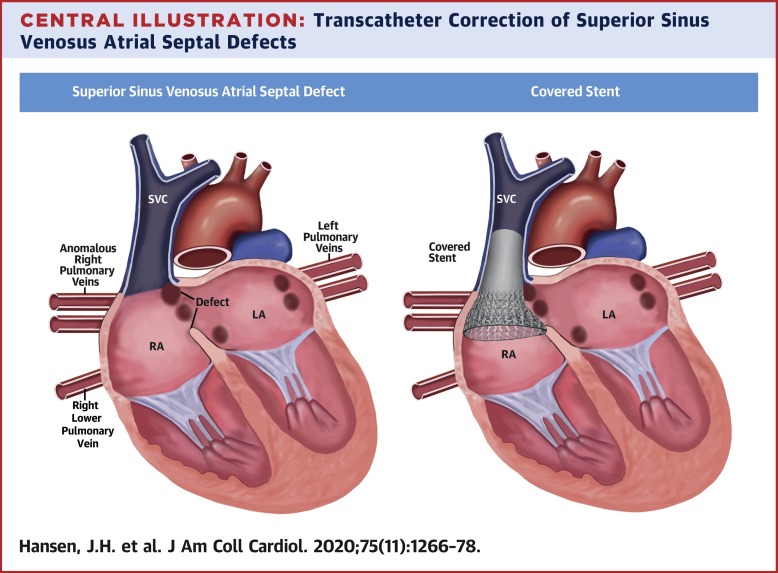当前位置:
X-MOL 学术
›
J. Am. Coll. Cardiol.
›
论文详情
Our official English website, www.x-mol.net, welcomes your
feedback! (Note: you will need to create a separate account there.)
Transcatheter Correction of Superior Sinus Venosus Atrial Septal Defects as an Alternative to Surgical Treatment
Journal of the American College of Cardiology ( IF 21.7 ) Pub Date : 2020-03-01 , DOI: 10.1016/j.jacc.2019.12.070 Jan Hinnerk Hansen , Phuoc Duong , Salim G.M. Jivanji , Matthew Jones , Saleha Kabir , Gianfranco Butera , Shakeel A. Qureshi , Eric Rosenthal
Journal of the American College of Cardiology ( IF 21.7 ) Pub Date : 2020-03-01 , DOI: 10.1016/j.jacc.2019.12.070 Jan Hinnerk Hansen , Phuoc Duong , Salim G.M. Jivanji , Matthew Jones , Saleha Kabir , Gianfranco Butera , Shakeel A. Qureshi , Eric Rosenthal

|
BACKGROUND
The superior sinus venosus atrial septal defect (SVASD) is characterized by deficiency of the common wall between the superior vena cava (SVC) and the right upper pulmonary vein (RUPV), which is no longer committed to the left atrium. OBJECTIVES
This study sought to evaluate the potential for redirecting the SVC and RUPV flow to the right and left atria, respectively, by implantation of a covered stent in the SVC. METHODS
Review of 48 consecutive adult SVASD patients undergoing assessment for correction. Pre-procedural evaluation included cross-sectional imaging and ex vivo simulation using printed or virtual 3-dimensional models. RESULTS
Transcatheter correction was performed in 25 patients, with a further 6 awaiting stent implantation. Only 8 patients were deemed technically unsuitable. The procedure involved balloon test inflation in the anticipated stent landing zone with simultaneous transesophageal echocardiography and pulmonary venography to confirm defect closure and unobstructed pulmonary venous drainage, followed by deployment of a 10-zig covered Cheatham platinum stent. Stents of lengths between 5 and 8 cm were implanted. A second, uncovered stent was used for anchoring in 9 patients. The RUPV was protected with a high-pressure balloon during stent implantation to prevent pulmonary venous obstruction in 4 patients. The median follow-up period was 1.4 (interquartile range: 0.8 to 1.7) years, with no mortality. Stent embolization occurred in 1 patient; another required drainage of hemopericardium. Cardiac computed tomography after 3 months confirmed unobstructed pulmonary venous return. At latest follow-up, a residual shunt was present in 1 patient. CONCLUSIONS
Transcatheter correction of SVASD may be considered as an alternative to surgery in a substantial proportion of patients.
中文翻译:

经导管矫正上静脉窦房间隔缺损作为手术治疗的替代方案
背景上窦静脉房间隔缺损(SVASD)的特点是上腔静脉(SVC)和右上肺静脉(RUPV)之间的共同壁缺损,右上肺静脉不再向左心房转移。目的 本研究旨在评估通过在 SVC 中植入覆膜支架将 SVC 和 RUPV 血流分别重定向至右心房和左心房的可能性。方法回顾 48 名连续接受矫正评估的成年 SVASD 患者。程序前评估包括使用打印或虚拟 3 维模型的横截面成像和离体模拟。结果 25 名患者进行了经导管矫正,另有 6 名等待支架植入。只有 8 名患者被认为在技术上不合适。该程序包括在预期的支架着陆区进行球囊充气测试,同时进行经食道超声心动图和肺静脉造影,以确认缺损闭合和肺静脉引流通畅,然后部署 10 字形覆盖的 Cheatham 铂支架。植入长度在 5 到 8 厘米之间的支架。第二个未覆盖的支架用于固定 9 名患者。4 名患者在支架植入过程中使用高压球囊保护 RUPV,以防止肺静脉阻塞。中位随访期为 1.4(四分位距:0.8 至 1.7)年,无死亡。1例患者发生支架栓塞;另需引流心包积血。3 个月后的心脏计算机断层扫描证实肺静脉回流通畅。在最近的跟进中,1 名患者存在残余分流。结论 经导管矫正 SVASD 可被视为相当一部分患者的手术替代方案。
更新日期:2020-03-01
中文翻译:

经导管矫正上静脉窦房间隔缺损作为手术治疗的替代方案
背景上窦静脉房间隔缺损(SVASD)的特点是上腔静脉(SVC)和右上肺静脉(RUPV)之间的共同壁缺损,右上肺静脉不再向左心房转移。目的 本研究旨在评估通过在 SVC 中植入覆膜支架将 SVC 和 RUPV 血流分别重定向至右心房和左心房的可能性。方法回顾 48 名连续接受矫正评估的成年 SVASD 患者。程序前评估包括使用打印或虚拟 3 维模型的横截面成像和离体模拟。结果 25 名患者进行了经导管矫正,另有 6 名等待支架植入。只有 8 名患者被认为在技术上不合适。该程序包括在预期的支架着陆区进行球囊充气测试,同时进行经食道超声心动图和肺静脉造影,以确认缺损闭合和肺静脉引流通畅,然后部署 10 字形覆盖的 Cheatham 铂支架。植入长度在 5 到 8 厘米之间的支架。第二个未覆盖的支架用于固定 9 名患者。4 名患者在支架植入过程中使用高压球囊保护 RUPV,以防止肺静脉阻塞。中位随访期为 1.4(四分位距:0.8 至 1.7)年,无死亡。1例患者发生支架栓塞;另需引流心包积血。3 个月后的心脏计算机断层扫描证实肺静脉回流通畅。在最近的跟进中,1 名患者存在残余分流。结论 经导管矫正 SVASD 可被视为相当一部分患者的手术替代方案。

































 京公网安备 11010802027423号
京公网安备 11010802027423号